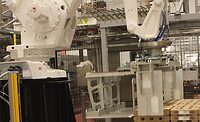COVID-19
Humidity Control: Conquering frost during pandemic production levels

When you are moving more product, the doors have to stay open, which means the frost load is going to spike – especially if you’re running seven days a week.
Humidity control may be the last thing on your mind right now if you’re running a food processing facility, trying to execute a rapid buildout to meet increased consumer demands.
But, as you race to adjust production lines, “dust off” old processing equipment and ultimately ramp up how much food you’re making and storing, dialing in your humidity control will eliminate a handful of costly issues that slow down production.
The situation
First, some context. Why are we talking about this now? Simple – COVID-19 has sent our economy into a whirlwind and nowhere has it been as evident as in the food processing industry.
Over the first couple weeks of the stay-at-home order, refrigerated and frozen food sales spiked. Some examples: Frozen pizza sales increased 117.2%, while frozen cookie dough spiked 570.4%. That’s essentially like having a grocery store that only serves Cookie Monster and his extended family.
While sales have slowed from that initial spike, they’re still above average, according to the Consumer Spending Tracker for MULOC Retailers. And that means two things: Processing facilities are going to continue to deal with significant production boosts – and the moisture issues that come with those changes.
This isn’t a problem that’s new to food processors. It’s an amplified problem. When you are moving more product, the doors have to stay open, which means the frost load is going to spike – especially if you’re running seven days a week.
Humidity control issues you’ll face
When quickly changing from one type of production to another, or simply increasing production levels significantly, you’re most likely going to have humidity cause some problems. And that’s only going to get truer as we quickly move into warmer months.
Food processors are reaching out to us with three primary issues:
Infiltration issues – All kinds of moisture is sneaking in from the outside, affecting new and existing processing areas.
Mechanical integrity – When old processing equipment is called back into duty, moisture collecting on the equipment is going to cause corrosion issues.
More processing equals more frost – From frost buildup to longer cleanup cycles, moisture is impeding production.
A lot of plant managers are saying ‘let’s get it up and running to make or store whatever and we’ll deal with the problems down the line. The frost problem is days and weeks down the line.’ But in reality, the problem is going to pop up quickly – especially as outside temperatures increase.
Tackle infiltration
During a rapid buildout, the first thing I do is identify any locations where outside air is infiltrating the storage facility or processing plant.
First and foremost, when production spikes so does loading dock traffic. That means doors are opening more often and generally those doors aren’t in the greatest condition, making humidity control a challenge.
To manage those door issues, the first step is simple: Repair the doors. But, you may also want to raise the evaporator temperature and introduce supplemental dehumidification.
Because of the low temperatures in a cold storage facility, you’re going to want to use a desiccant dehumidifier that can operate below freezing. Capturing that moisture at the infiltration point is critical.
Another challenge is when building out “new” processing areas. For instance, maybe you’re now using what used to be an unconditioned hallway to make frozen pizza. That’s going to cause problems.
To solve the problem, you need to first ask a few questions:
Where is the moisture coming from? Can you effectively plug up the point of infiltration to cut off the humid air?
Is there an exhaust process pulling humid air into the room?
Then, spend time examining the air flow.
You want to know where the make-up air is originating. Then, you can start to decide whether it’s more cost effective to treat the makeup air or the room it’s in.
Get more out of your equipment
OK, so you have no choice but to pull out some old(er) processing equipment and you’re having to run it in unconditioned areas. What to do, what to do?
Walk through these four steps (along with tackling infiltration) – Every. Time.
- Perform an IIAR Standard 6 MI inspection of refrigeration equipment
- Examine past records for moisture related operational issues.
- Seal off the room as much as possible from infiltration
- Condition both the room and the source of makeup air as much as possible.
So often, these few steps can eliminate problems before they ever arise. It can seem like a burden to add any additional work when you’re in the midst of a rapid buildout but dealing with humidity control upfront will ultimately keep you from having to slow production to fix related issues.
Add dehumidification (especially outside first)
Ultimately, it’s likely you’ll need to layer in some additional humidity control to manage the increased moisture and infiltration of humid air. But, if you take other steps first, it’s possible you won’t need nearly as much dehumidification and can save dollars and resources.
Multiple variables determine the amount of dehumidification you need and also where to place it. But, a good place to start is managing “outside” air.
When we say ‘outside air’ we’re referring to air infiltrating the storage or production area from adjacent rooms. It’s easier and more efficient to dehumidify that air first, therefore never allowing it to enter the plant.
The reason? Capturing air at higher temperatures (prior to it entering the plant), allows the dehumidifiers to process more air and deal with more moisture. Desiccant dehumidifiers are most efficient when the air is filled with moisture.
It’s a simple solution, but one we’ve found has a positive, immediate impact on operations where humidity is causing significant problems, such as frost.
Looking for a reprint of this article?
From high-res PDFs to custom plaques, order your copy today!









